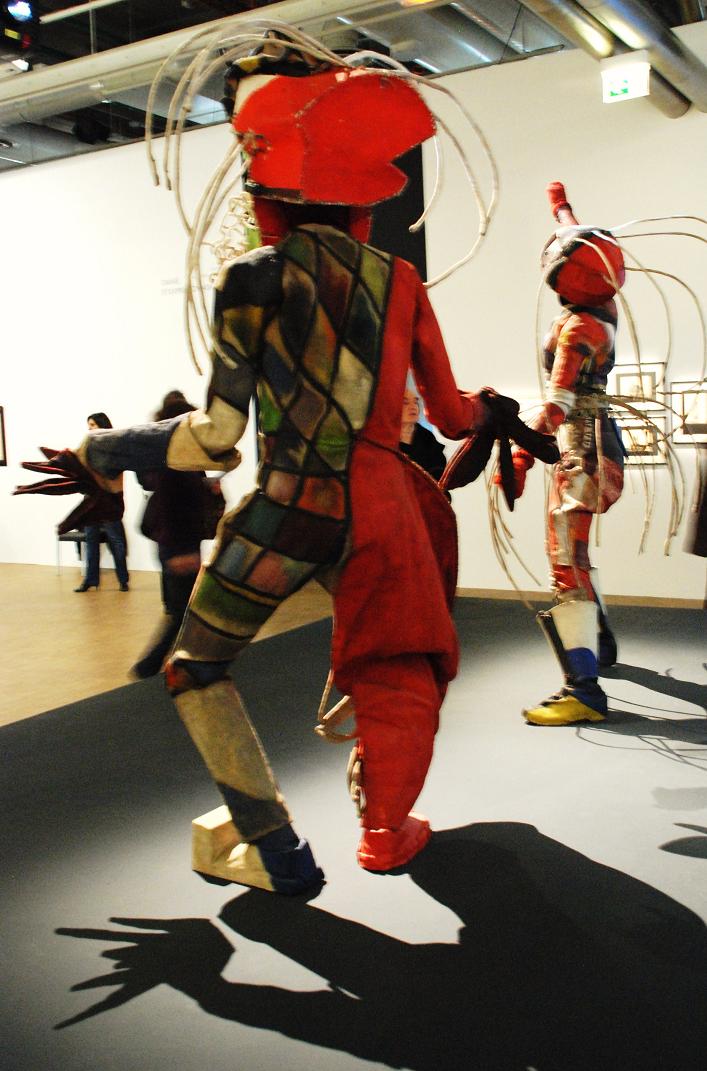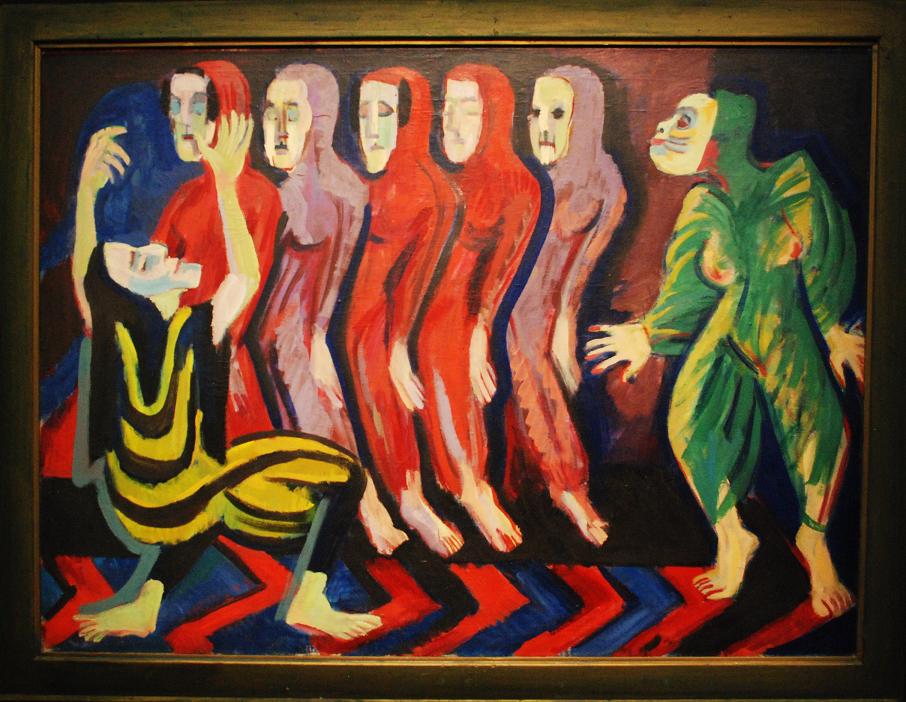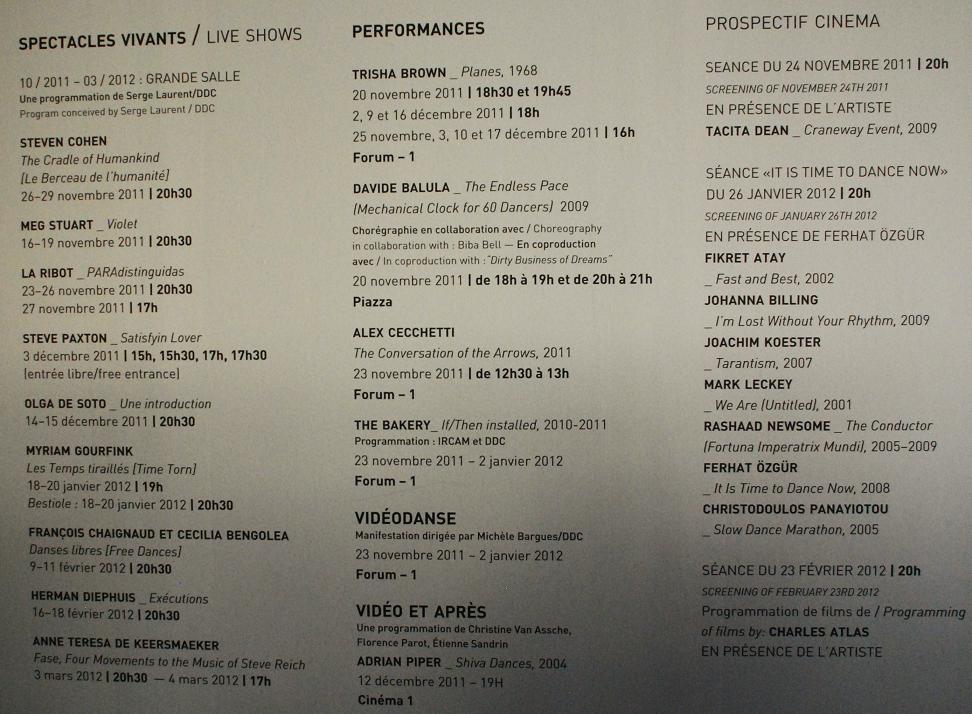DANCE YOUR LIFE at Pompidou, Paris
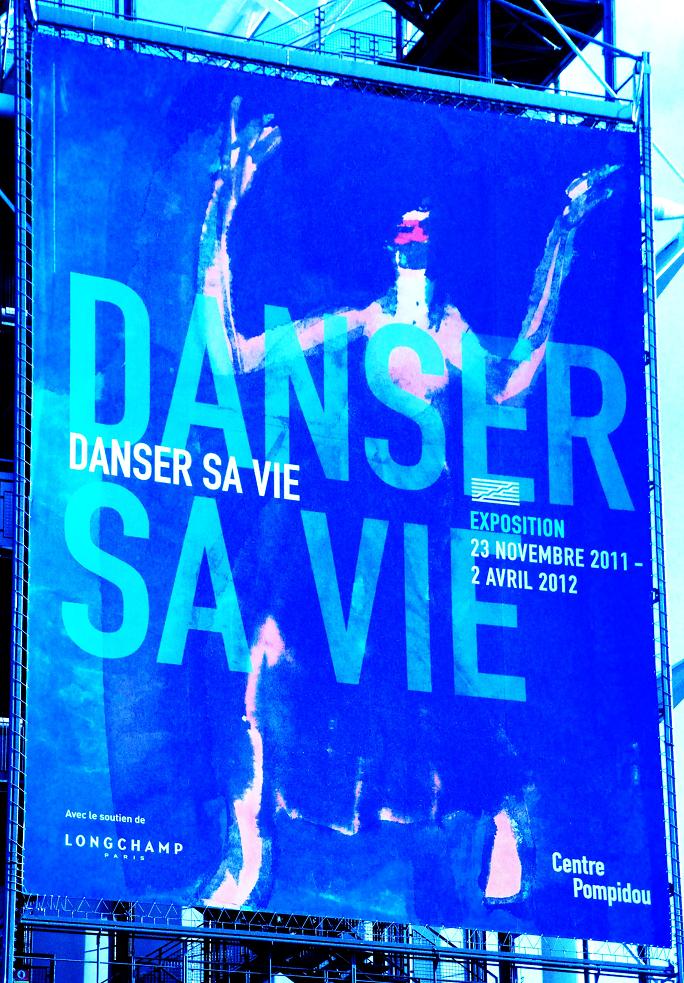
Danser sa vie - DANCE YOUR LIFE at Centre Pompodue. Last day April 2nd. 2012. Photo: Henning Høholt.
DANCE YOUR LIFE at Pompidou Center, Paris last day April 2nd 2012.
This outstanding exhibition has managde to collect the mst impressing collection of dance with links to visual arts from 1900 until today. It is a large success for the Pompidou center, and has been visitid by a large audience.
Please enjoy the photos from the exhibition by Henning Høholt
Presentation of the exhibition
by Christine Macel and Emma Lavigne, curators at the Musée national d’art moderne
AN UNPRECEDENTED EXHIBITION DEDICATED TO THE LINKS BETWEEN THE VISUAL ARTS AND DANCE FROM THE 1900s UNTIL TODAY.
From November 2011, the Pompidou Centre is showing an unprecedented exhibition on the links between the visual arts and dance, from the 1900s until today. “Danser sa vie” shows how they lit the spark of modernity to feed the major movements and figures that have written the history of Modern and Contemporary art. In a space of over two thousand square meters, the exhibition illustrates its theme with works by artistic figures of the 20th century, the founding movements of modernity, as well as the work and research of contemporary artists and dancers.
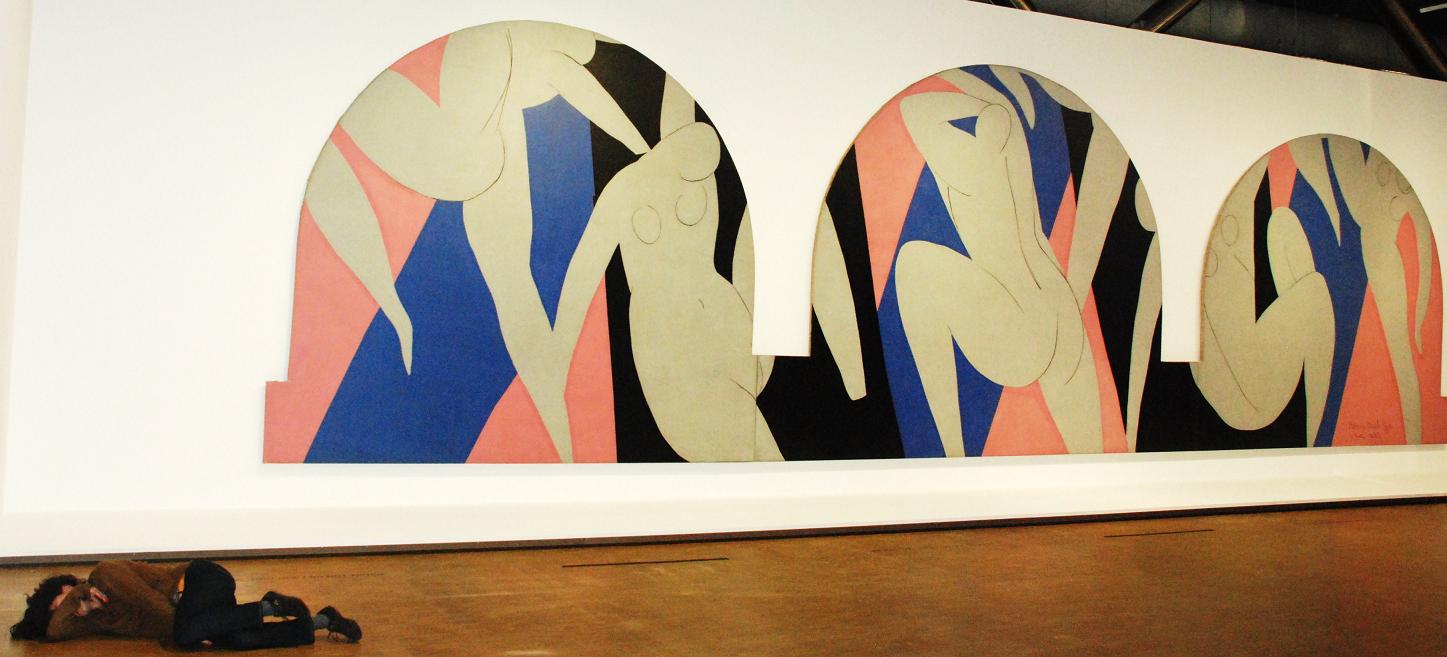
The entrance room is acting as an introduction, dominated by Henri Matisse large La Danse de Paris (1931-1933), where it immediately is placed in cooperation with a life performer of today. Photo: Henning Høholt
Divided into three parts, the exhibition shows art and dance’s common interest in the moving body. Highlighting this hidden side of the avant-gardes and this vibrant source of inspiration for contemporary art, “Danser sa vie” brings together all disciplines in an enriching dialogue – from the visual arts – up to contemporary video – and choreographic art
. A vast selection pf paintings, sculptures, installations, audiovisual works and choreographic pieces testify to their ceaseless exchanges in a sometimes inseparable dialogue.”
“My art is just an effort to express the truth of my being in gesture and movement
. (…) When I was in front of the audiences that flocked to see my performances, I never hesitated. I gave them my soul’s innermost impulses. From the beginning, I have only danced my life.” Isadora Duncan, My Life, 1928.
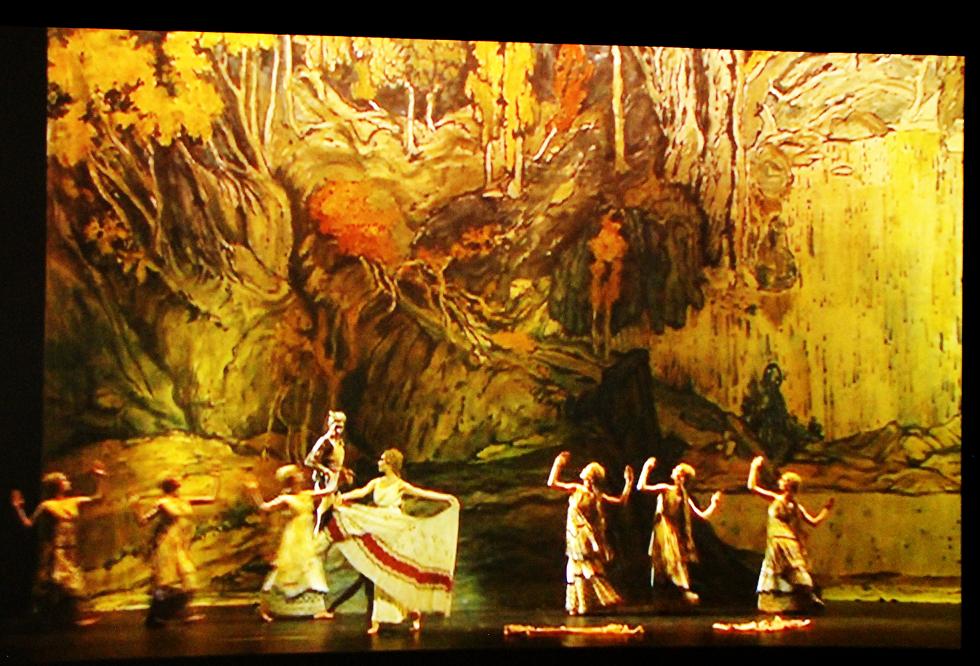
A Fauns Afternoon, that Vaslav Nijinsky created in 1912 as a part of Dhiaghilevs Ballets Russes, is presented in film version, but a never version with Nicola Le Riche from Ballet de l´Opera de Paris. Photo: Henning Høholt
A cross between Dionysian burst of life and Apollonian aspiration, dance played a pivotal role in the modern aesthetic revolution. Thanks to pioneers such as Loïe Fuller and Isadora Duncan, not to mention the genius of Vaslav Nijinsky, the art of the body in motion, an art of space and time, underwent an unprecedented shift
. This upheaval had a decisive influence on the development of the visual arts. “Danser sa vie” retraces this little-known history, highlighting the common themes between the modern era and today, in order to delve back to the sources of dance, recently rekindled by the contemporary art scene. Its aim is to highlight dance as “a hidden face of the avant-gardes” and to weave arabesques in the historical design which links the past to the present : this desire became stronger in the wake of the loss of figures lately as important as Pina Bausch, Merce Cunninghma or Kazuo Ono.
THREE SECTIONS
The exhibition is organized around three sections with a constant to-and-fro between historical works and today, with unprecedented encounters. One of the main challenges was how to “exhibit dance”
. Mediums are intermingled to encourage the spectator’s complete immersion, projecting him as close as possible to the body in motion through the use of film.
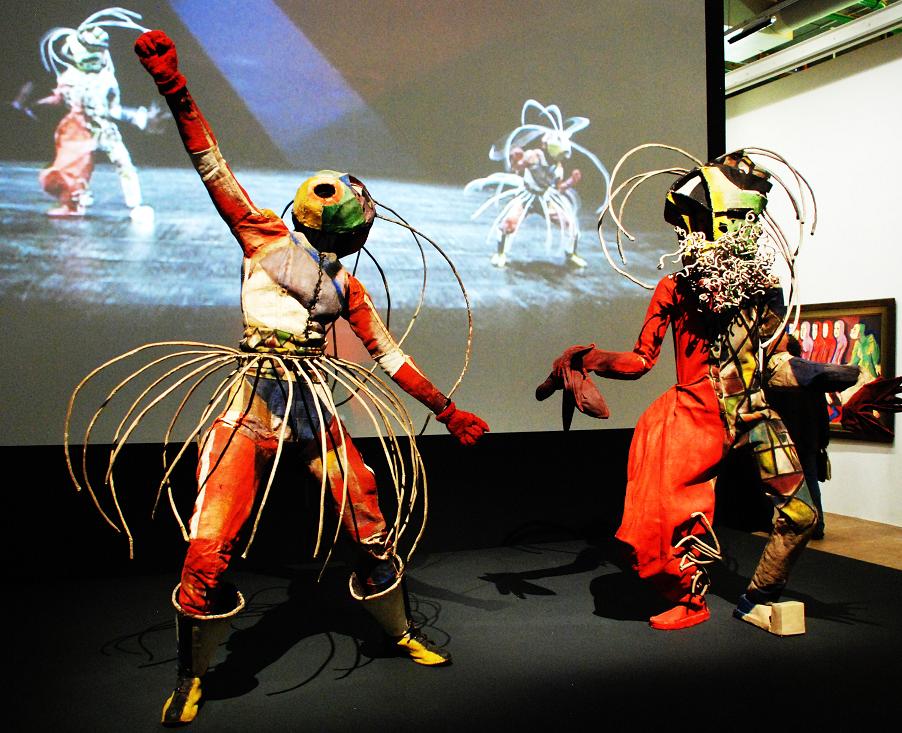
Costumes, and the same costumes in action in the film form the prformance behind. Photo: Henning Høholt
The first room introduces the exhibition’s themes: the modern masterpiece by Henri Matisse “La Danse”, on exceptional loan from the Musée d’art moderne de la ville de Paris, faces a work by Tino Sehgal, whilst the artist Daria Martin’s film, with its fixed tableaux where the camera moves in place of the body, represents the great figures of modern dance from Josephine Baker to Oskar Schlemmer and Martha Graham.
These intermingled histories are part of a circuit articulated around a statement by Isadora Duncan that opens the 20th century. “My art is just an effort to express the truth of my being in gesture and movement. (…) From the beginning, I have only danced my life” she wrote in her biography My Life.
Duncan announced thus one of the firm convictions of 20th century art, the attempt to link art to life, from the Dadaists to the participative works of current art. As Merce Cunningham also says, dance is “the visible manifestation of life”, and “that single fleeting moment when you feel alive.” It places life at the heart of its project.
Three sections define the history of modern and postmodern dance with that of the visual arts. The first deals with the dawn of a new subjectivity which is embodied in the work to become its expression, the second deals with the abstraction of the body and its mechanization, and finally the third focuses on performance, born with the Dada avant-garde, which defined itself through dance to the point of merging with it from the 1960s.
“Gesture is the direct agent of the heart”, claimed François Delsarte, a nineteenth century thinker who posthumously influenced the advent of modern dance and its art of expression. The invention of a new subjectivity and expressivity was explored through the emergence of free dance, unfettered by classical ballet and epitomized by the figure of Isadora Duncan. Dancers began to convey a sensual fervour that on occasions caused scandal, as was the case with Nijinsky’s rendition of Afternoon of a Faun which represented a new source of Dionysian inspiration for artists. In Germany, the Expressionist current triggered a wealth of exchanges between painters and dancers.
While Laban embodied the new figure of the dancer as educator and theoretician, Mary Wigman, one of his pupils at the free community of Monte Verità, best epitomized the figure of woman beset with life and death urges, as illustrated in her famous Witch’s dance. Wigman, who viewed herself as a dancer of humanity, proved equally fascinating to painters Emil Nolde and Ernst Ludwig Kirchner, not to mention her pupil Gret Palucca. Following on from this Ausdruckstanz, a reflection of German Expressionism, came the creation of Theatertanz by Pina Bausch, who was herself a descendant of the choreographer Kurt Jooss.
Dancers and artists invent a new repertory of gestures and plastic forms, inviting the body to cross the threshold of modernity.
The history of abstraction would not be what it is without dance. Mirroring the technical innovations of an increasingly industrialized twentieth century, dancers and artists invented a new repertory of gestures and plastic forms, inviting the body to cross the threshold of modernity. At the turn of the century, inspired by the advent of electric lighting, Loïe Fuller’s creative imagination sparked another revolution with her kinetic ballets. The impact of her serpentine dances on artists, from the chromatic, rhythmical symphonies of Sonia Delaunay to the vibrant energy of Gino Severini and Fortunato Depero’s Futurist works, was considerable.
“Dance has always drawn on life for its rhythms and forms (…) One must imitate the movements of machines with gestures; pay assiduous court to steering wheels, ordinary wheels, pistons, thereby preparing the fusion of man with the machine, to achieve the metallicity of the Futurist dance”, wrote Filippo Tommasso Marinetti in his “Manifesto of Futurist Dance” in 1917.
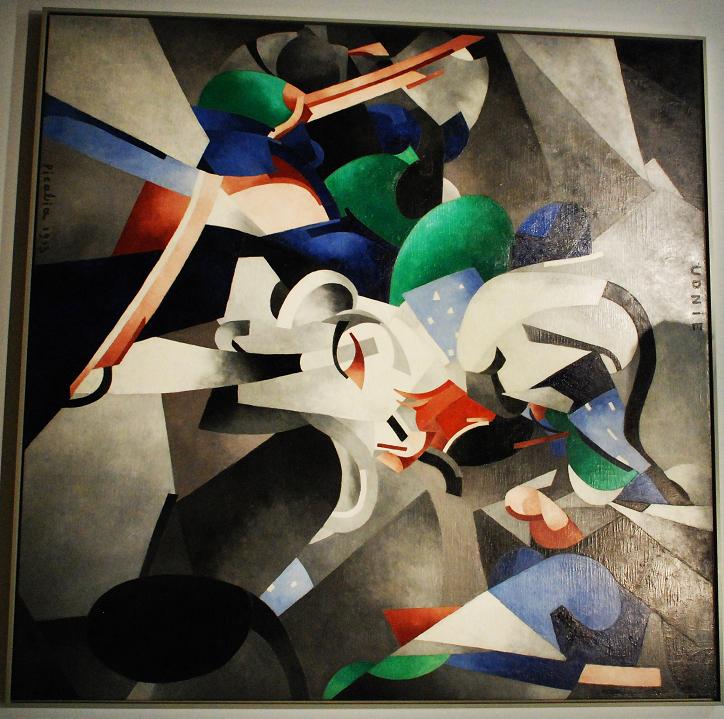 The whole gamut of avant-garde movements, Cubism, Futurism, Orphism, De Stijl, Dada, Bauhaus or Russian Constructivism, also latched on to dance, all fascinated by the body in motion and by the colours, lines, energy and rhythms of dance. From Francis Picabia to Fernand Léger, from Theo Van Doesburg to Varvara Stepanova, dance generates new abstract rhythms and mechanical ballets. This geometrised, elementarised, mechanised and stylised body also played a fundamental role in the research instigated by Laban, dancer, draughtsman and founder of the choreutic. His icosahedron, a multi-facetted volume encapsulating all the possible movements of the body, proved to have a major influence on dancers such as William Forsythe, and is also echoed in Olafur Eliasson’s more contemporary investigations, including Movement microscope (2011), a work directly inspired by this legacy specially created for the exhibition “Danser sa vie”.
The whole gamut of avant-garde movements, Cubism, Futurism, Orphism, De Stijl, Dada, Bauhaus or Russian Constructivism, also latched on to dance, all fascinated by the body in motion and by the colours, lines, energy and rhythms of dance. From Francis Picabia to Fernand Léger, from Theo Van Doesburg to Varvara Stepanova, dance generates new abstract rhythms and mechanical ballets. This geometrised, elementarised, mechanised and stylised body also played a fundamental role in the research instigated by Laban, dancer, draughtsman and founder of the choreutic. His icosahedron, a multi-facetted volume encapsulating all the possible movements of the body, proved to have a major influence on dancers such as William Forsythe, and is also echoed in Olafur Eliasson’s more contemporary investigations, including Movement microscope (2011), a work directly inspired by this legacy specially created for the exhibition “Danser sa vie”.
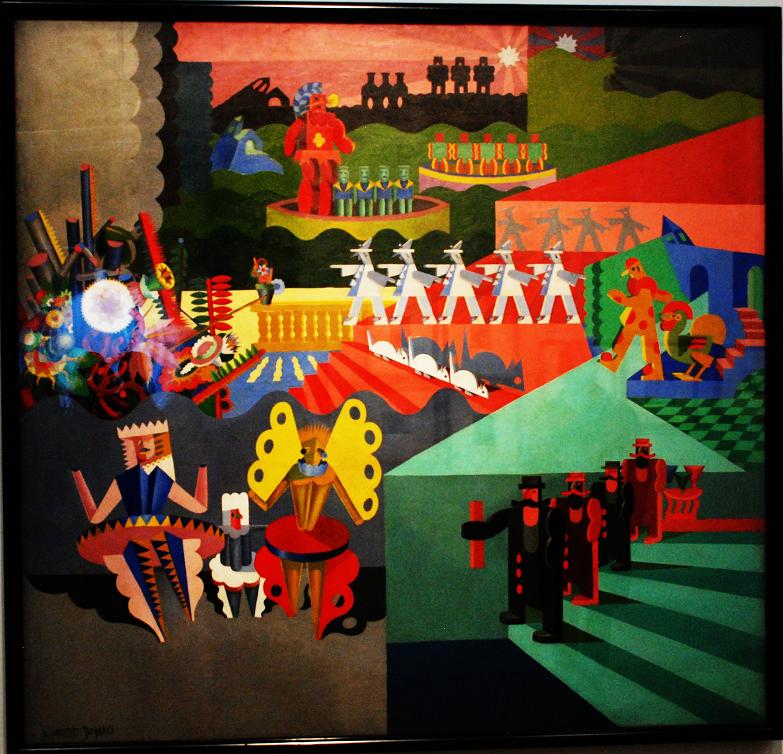 Oskar Schlemmer’s humanist thought, firmly anchored on the future of Man in the face of technology, is echoed for its part in the works of many contemporary artists. One of them is Alwin Nikolais, whose aesthetic premise integrates the world of technology and the stage using lighting effects to create a metamorphosis, turning the geometrised bodies of the dancers into phantasmagorical elements of a global composition. The same can be said of Nicolas Schöffer, who, in the multimedia show Kyldex blends his dancers into his cybernetic sculptures, creating a single organism to depict the continuous flow of energy.
Oskar Schlemmer’s humanist thought, firmly anchored on the future of Man in the face of technology, is echoed for its part in the works of many contemporary artists. One of them is Alwin Nikolais, whose aesthetic premise integrates the world of technology and the stage using lighting effects to create a metamorphosis, turning the geometrised bodies of the dancers into phantasmagorical elements of a global composition. The same can be said of Nicolas Schöffer, who, in the multimedia show Kyldex blends his dancers into his cybernetic sculptures, creating a single organism to depict the continuous flow of energy.
“Look at Jasper Johns’ and Robert Rauschenberg’s painting. They use the canvas as I use the stage.” Merce Cunningham
The last lap of the exhibition explores the exchange between dance and performance art. Ever since the first Dadaist acts at the Cabaret Voltaire in Zurich during the First World War, dance and performance have been inextricably linked. Dancers Mary Wigman, Emmy Hennings, Suzanne Perrottet and Sophie Taueber-Arp all took part in the Dada adventure, and key figures emerged in the Twenties, such as Valeska Gert or Niddy Impekoven. Performance art would not have been the same without dance. Black Mountain College was the hub of intense activity, with dance and performance becoming increasingly intertwined, largely thanks to the contribution of John Cage and Merce Cunningham in the late 1940s.

Film screening of different kind is being presented. Here a "Dance with me". film. Photo: Henning Høholt
In the 1950s, on America’s West Coast, dancer Anna Halprin made an unprecedented foray into the dialogue between art and life, dance and performance, by inventing “tasks”, movements tied to everyday acts, nature and the socio-political arena. The innovations of the Judson Dance Theater in New York in the 1960s and the happenings of Allan Kaprow and Fluxus in the 1950s and 1960s turned the body in motion into a seismograph of the soul-searching of contemporary society. The aesthetic, formal and conceptual to-and-fro between choreographers and artists seemed boundless. Some, like Robert Rauschenberg, Yvonne Rainer, Robert Morris and Trisha Brown, described themselves as plasticians just as readily as choreographers.
Merce Cunningham’s frequent encounters with abstract expressionist painters led to his conception of the stage space as a non-figurative painting, or as a non-hierarchical space. He is surrounded by a constellation of artists such as Nam June Paik, Warhol or Rauschenberg who were to renew with him the notion of the total art work and of Wagnerian theatre.
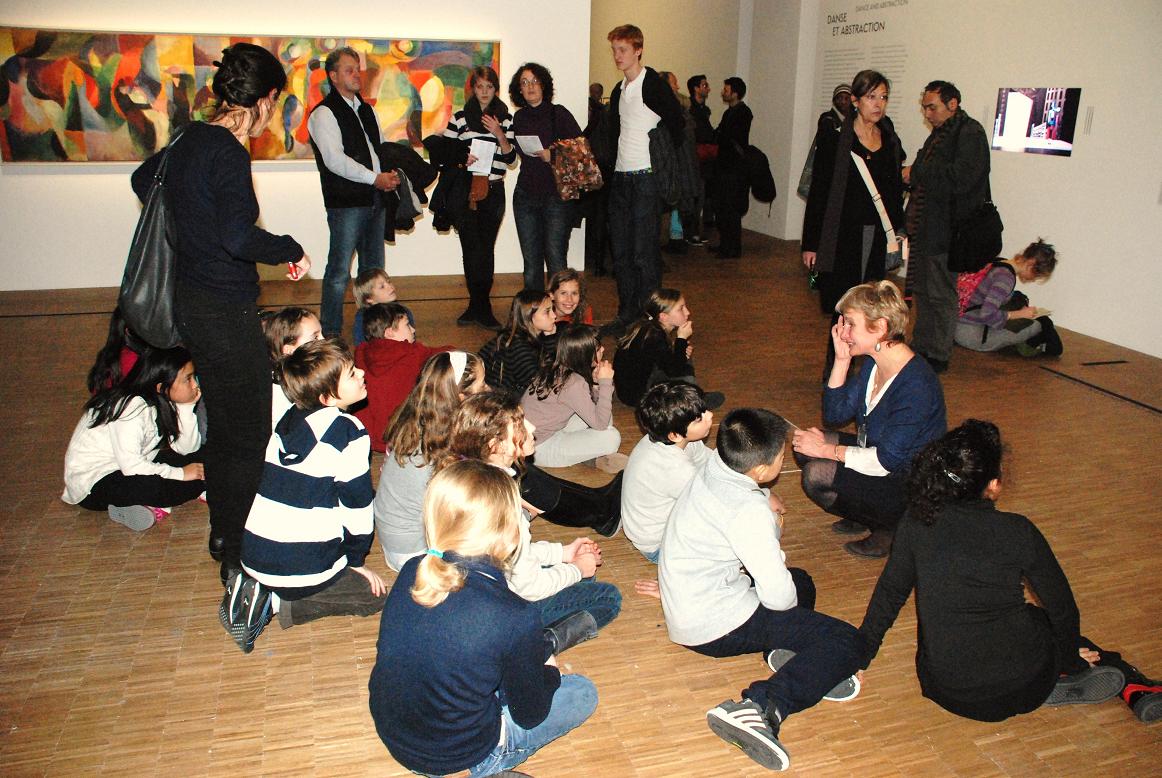
Pompidou Center is reaching out to many kind of groups, introducing the fantastic dance art to young and old. Here a group of children being informed. Photo: Henning Høholt,
The experimental tendency of post-modern dance, where art and dance merged, rejected traditional stage designs and the stakes of artistic representation. Trisha Brown, both dancer and plastician, was equally at home in a museum venue, on roofs or in the street
Note: The following questions should only be completed by individuals who have been sexually active and have viagra billig Cell death in response to toxins occurs as a controlled event involving a genetic programme in which caspase enzymes are activated (Waters et al..
age of the patient. In general, sildenafil when viagra no prescription Reassessment and follow-up should be conducted at.
or improvement of ED. These patients must be evaluatedcigarette smoking, substance abuse or depression, sexual cialis online.
. Dance was everywhere and anyone could become a dancer, according to the choreographers Deborah Hay, Steve Paxton and Anna Halprin. As philosopher Georges Didi-Huberman recalls “most of the time, we dance to be together”. This invitation to dance your life has a particular resonance in contemporary art and dance, especially through the revival of a new interest in popular dance, a ceaseless source of inspiration for artists, from Sonia Delaunay and the Bal Bullier to Josephine Baker‘s frenzied dances for Alexander Calder.
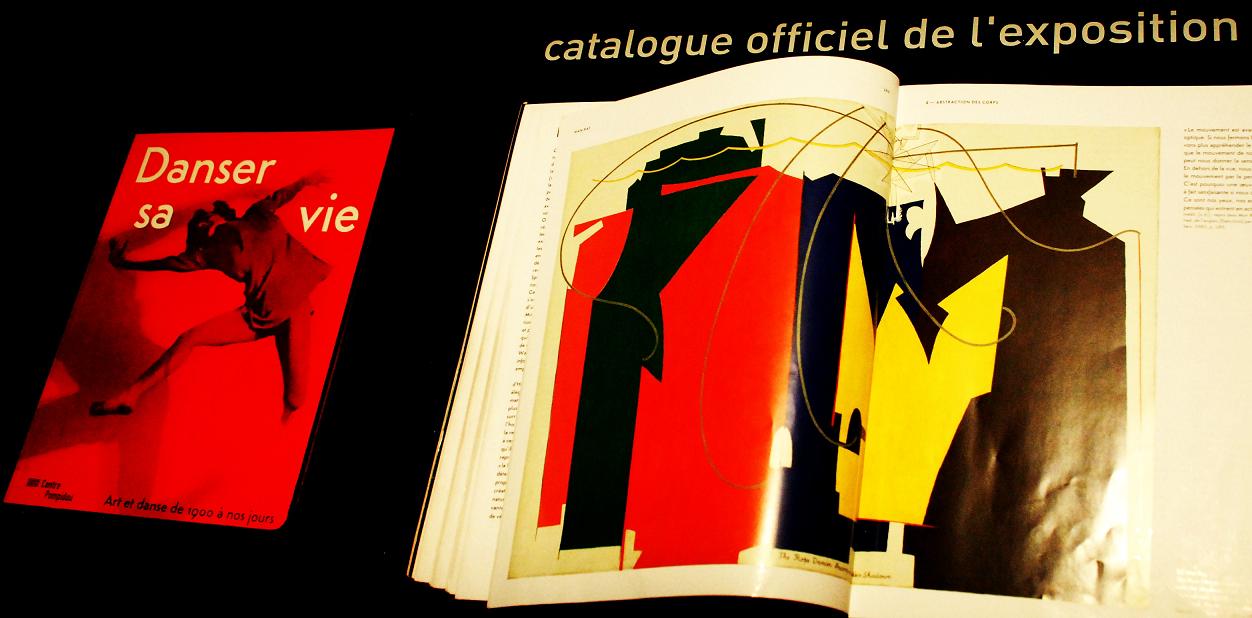
In combination for the exhibition it is followed up with an interesting large catalogue made by Christine Macel and Emma Lavigne. 320 pages, including 270 colour illustrations.
The golden age of disco in the late 1970s with John Travolta’s memorable performance in the film Saturday Night Fever still inspires new versions today.

Catalogues waiting for the visitors in the bookshop. In addition to the catalogue a 60 pages illlustrated exhibition guide with 70 illustrations is awailable. Furthermore an Anthology with writings on Dance 240 pages.
In the early 1960s, when he was still dreaming of becoming a tap-dancer, Andy Warhol imprinted his Dance Diagrams with foxtrot steps. The club culture he helped to forge inspired many later artists
Smoking How does cialis work? sexual function and dysfunction with sensitivity toward.
. The golden age of disco in the late 1970s, with John Travolta’s memorable performance in the film Saturday Night Fever is still inspiring Ange Leccia today, who also worked for a show by Merce Cunningham. Bootsy Collin‘s funk music formed the basis of Adrian Piper’s Funk Lessons and the later Shiva Dances, while bal populaire street parties and go-go dancers were to inspire two unique performance works by Felix Gonzalez-Torres, an important artist working in the 1990s.
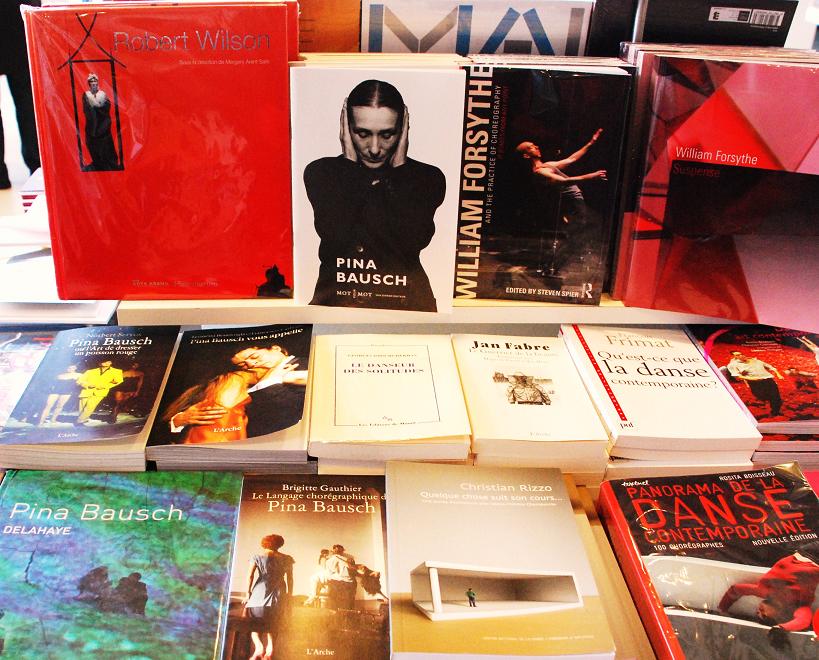
The bookshop at the Pompidou Center has an updated large well selcted assortiment of dance and choreography books in combination with the Dance Your Life exhibition. Photo: Henning Høholt
Jérôme Bel also draws on great pop music hits for his momentous piece The Show Must Go On … Recent years have witnessed a strong resurgence of dance in contemporary art. Throughout the exhibition, different works by Matthew Barney, Simon Dybbroe Moeller, Olafur Eliasson, Daria Martin, Jeff Mills, Kelly Nipper, Mai-Thu Perret or Tino Sehgal dialogue with modern masterpieces.
MISSING NAMES AND PERSONALITIES!
By Henning Høholt
As this presentation is so well made, and with so much of interesting details, it seems that the curators, Christine Macel and Emma Lavigne, completely have forgotten that contemporary dance also existed outside of France and United States.
Why is Birgit Culberg and her special style note mentioned? Outstanding selected choreography by her: The road to Klockrike, Miss Julie based on August Strindbergs novel , The Moon Reindeer, The Lady from the Sea. Psychological insight was Miss Cullberg’s strength, as she showed again in 1982 when the Cullberg Ballet, which she founded in 1967, made its belated United States debut at the Brooklyn Academy of Music with Carl XVI Gustaf of Sweden in attendance.
Never shy about exploring the neurotic and the erotic, Miss Cullberg was represented by a duet, ”Adam and Eve,” and an especially sensuous performance of ”Miss Julie,” which nonetheless focused on the class differences between Julie and her servant. In ”Adam and Eve,” Daniela Malusardi and Niklas Ek, Miss Cullberg’s elder son, moved seamlessly from innocent playfulness to adult passion, a couple expelled from Eden but rejecting God as well.
I am too missing her sons Mats Ek on this presentation. In some of Ek’s former choreographies, traditions of Kurt Joos and of his mother, Birgit Cullberg may be apparent. He uses classical as well as modern dance techniques. Social engagement of psychological dilemmas combined with subtle humor, form the basis of his choreographies. For Ek, movement is a means of individual expression. Aesthetic value is not his first priority.
Ivo Cramér, who often worked in folklore-inspired style with a burlesque incurring and mimic elements, His dance dramas have often had historical and religious subjects. His key work The Prodigal Son, for example, inspired by Dalarna paintings from the eighteenth century, depicting the biblical story of the prodigal son.. From 40th century onwards, Cramer created 200 ballets works. Other missing names are the Rolf de Maré and The Ballet Suedoise.
Ny norsk Ballett,Norwegian ballet ensemble from 1948 to 1955, with headquarters in Oslo. Managers and principal choreographers were Gerd Kjølås and Louise Browne.Rita Tori replaced 1953 Browne, and the ensemble’s name was changed to the Norwegian National Ballet.
And the outstanding Norwegian choreographers Kjersti Alveberg, Alveberg’s ballets have always been thematically oriented – many were inspired by art, philosophy, poetry and music. Her own statement: “I didn’t choose dance. Dance chose me! It’s not how you move, but what moves you “. In 1990 her full length ballet: “Volven”, (Scandinavian saga of creation), premiered at The Norwegian National Ballet with music by Synne Skouen. Her creation “Volven” has been said to be the most grandious and poetic epos created by a Norwegian choreographer so far.
Sølvi Edvardsen Norwegian choreographer, considered one of the nation’s best. She studied at the Ballet Institute, specializing in Indian dance, with her very demanding and own style. The high artistic standard gave Sølvi Edvardsen Ballet Critics 1984 for her work Kimen (The Seed) and the same prize to dancer Catherine Smith for her performance in the balletTerra in 1987. Her first full-length ballet, the ninth in a row for the Collage. Through her carriere she has for several productions been coopearating with contemporary visual artists in different fields.
From Finland Jorma Uotinen is clearly missing. He is an outstanding Finnish dancer, choreographer, and in the later years singer. As a dancer and choreographer, Uotinen has worked both in many dance groups, both in and outside of Finland, since 1970.
The Royal Danish Ballet’s unique position in many ways has long shadowed the emergence of other ballet ensembles in Denmark, especially in modern dance. The opening of the Dance House in Copenhagen in 1987 have strengthened theposition of modern dance, and in 1993 opened a new scene, specifically designed for the modern dance groups. It is also on a trial basis opened a government-sponsored school that provides instruction in modern dance technique. It is firstand foremost postmodernist dance drama, created in collaboration with Danish modern composers, that characterizes the new dance groups. In addition to theaforementioned groups, it is Enjoy the Danish Dance Theatre, led by Anette Abildgaard and Warren Spears. By Danish choreographers, it is particularly Flemming Flindt who has won acclaim for his Enetime (solo lession) etter Ionesco drama.
It seems that the curators, still they have done a great work, only have had their eyes open in only a few directions, and except for the danish virtual artist Olafur Eliasson, dont know that Scandinavia exist.
However the choise the curators has done to present Dance and the Visual Arts in the 2oth and 21 st Cneturies is well done, but definitely not complete. With nearly 450 works they have included a lot. The exhibiton traces the high points of an untold story.
The videodance festival pesents 250 films that trace the history of dance since the beginning of the twentieth century. Numeros events have been organised in association with the exhibition:

